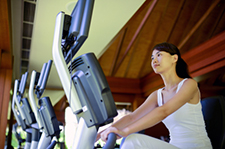A friend of mine recently told me about a deal she cut with her twelve-year-old for the summer: He’s allowed to play video games for an hour a day, provided he spend at least two hours running around outside first. She was starting to get worried about how much time he spent indoors in a sedentary position.
Of course, she’s not alone. For decades, parents have been worried about their kids sitting around too much, and the problem seems to grow worse each year. And this issue affects adults too! After my friend told me about the deal she made with her son, she admitted that she’d privately made a deal with herself as well: She’s allowed to watch television at night (and, she sheepishly said, to play her own video games) only if she’s managed to take 10,000 steps during the day.
But what if she could take her 10,000 steps while playing video games? I wouldn’t advocate this for her son — I want him to get outside and learn the joys of real-life play before he gets bogged down in all the grown-up responsibilities that make it such a challenge for his mother, for all of us, to get the exercise we need. But new developments in video games designed for the purpose of enhancing workouts could help us feel like we’re getting in both the exercise we need and the kind of entertainment-relaxation we want.
Blue Goji is a company aiming to produce video games for workouts. Established by the creators of the popular video game Guitar Hero, Blue Goji has spent several years devising games that can safely be used on the treadmill or elliptical, and that track exercisers’ heart rates and other data. The idea, the creators have explained, is to provide distraction from the workout so that exercisers don’t even pay attention to the pain and boredom and discomfort they might be feeling. Television monitors attached to exercise machines — or just stands that hold magazines while you run — have long served this purpose. Through interactivity and the incentive of having something to win, video games might do so as well, perhaps even more effectively. Also, video games are potentially more addictive — this time, in a good way. If you start a workout game, you might be highly motivated to get back to the workout so that you can continue playing the game.
The Wii console has melded physical activity and video game play for a long time, but Blue Goji’s product is made exclusively for use on gym equipment. Other companies are working on similar products, and also on other types of video game exercise products, such as ones that use virtual reality devices. What does all this mean for gyms and fitness centers? It might be time to start researching how you could incorporate video games and exercise into your facility’s offerings.


